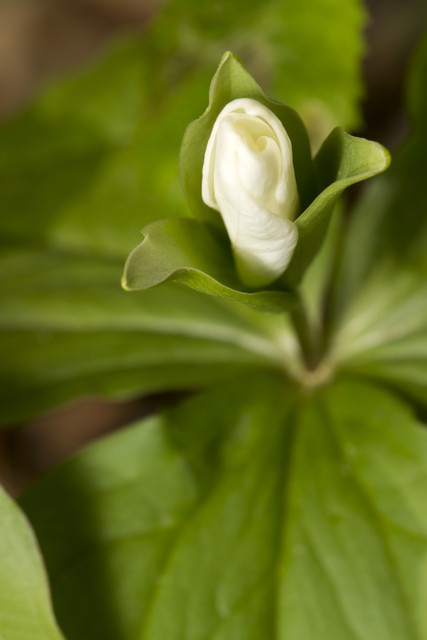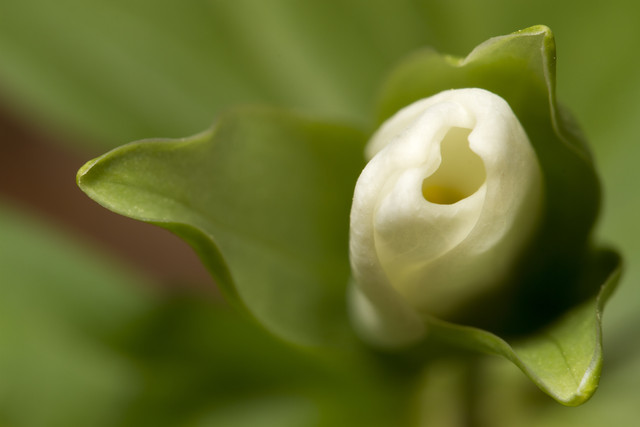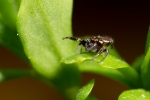Trillium Trails: White Trillium Bud
ktuli — Mon, 05/02/2011 - 20:14
When we visited the park the other day, almost every trillium in the area was fully bloomed, so when we spotted this bud, it made for a nice alternative to the rest of the shots I was getting. I (intelligently) shot both horizontal and vertical views of the bud, so we'll review both of them today.
We'll start with the vertical shot. Here I wanted to use the larger leaves to provide a nice background, but to still maintain some definition of their patterns, particularly on the one at the bottom of the frame.
Technical Data: Canon EOS 7D, Canon EF 100mm f/2.8L Macro IS USM, 1/250 sec at f/11. Canon Speedlight 580EX II flash in auto mode and wireless control. Image Stabilization on. ISO 200. RAW processing and cropped in Adobe Camera Raw. Trillium Trails, Fox Chapel, PA.
Why This Photo: Given a partially open bud in seas of trilliums in full bloom (tune in tomorrow for more on that), I simply couldn't pass up the opportunity. The initial shape of the bud with the petals wound together in a rather tall vertical bud to me warranted the vertical format.
What Works: The exposure is well balanced - keeping detail even in the white petals of the bud, and the focus is sharp at the closest edges of the flower and surrounding leaves. The depth of field with an aperture of f/11 is just barely enough to keep the bud in clarity, but blurs everything else softly - though maintaining enough clarity to show the vein pattern in the front leaf.
What Doesn't Work: The brown ground showing between the leaves is somewhat distracting, but not nearly as bad as the stray leaf from a neighboring plant in the bottom left corner. The bruise on the leaf to the upper left is a little distracting as well, and a slightly different angle may have hid that behind the flower. If that had been properly hidden, more depth of field might have worked better to show the leaf patterns better.
Before we move on to the horizontal photo, there are a couple items I want to point out.
First, when people see a trillium for the first time, they often assume that the name comes from the three petals to the flower. Which is partially correct, but if you notice, everything on this plant is in sets of threes. Often times the petals of the flowers are so spectacular that they over shadow the fact that the leaves enclosing the bud until it blooms are in a set of three, as are the leaves further down the stem. It is this repeated sets of three pattern that gives the plant its name, and I feel these shots with the flower still closed help to illustrate that a little better.
Another item of note between these two photos is how focal distance - the distance from the camera to the subject - affects depth of field. All other factors being equal, the further you are from a subject, the greater your depth of field. In these examples, the vertical shot has a focal distance of 0.39 meters, whereas the horizontal is only 0.30 meters - a difference of only 0.09 meters or just over 3.5 inches. However, where the vertical shot is able to keep the entire flower bud in clarity, the horizontal shot is barely able to show half of the bud before the depth of field causes it to blur. In all fairness though, there is one other factor at work here, and that is a slightly different angle. The vertical shot uses a more glancing angle to keep more of the bud in the crisp depth of field, whereas the horizontal shot exaggerates the depth of field by being shot straight on. Still interesting to see how a slight reposition of the camera can have such a dramatic effect with the exact same settings.
Anyway... on to the horizontal shot.
Technical Data: Canon EOS 7D, Canon EF 100mm f/2.8L Macro IS USM, 1/250 sec at f/11. Canon Speedlight 580EX II flash in auto mode and wireless control. Image Stabilization on. ISO 200. RAW processing and cropped in Adobe Camera Raw. Trillium Trails, Fox Chapel, PA.
Why This Photo: After shooting the bud in the vertical format, I felt I still wanted to work with this subject a bit more, and thought I would try a horizontal. To eliminate some of the distractions that the same positioning as the vertical would have provided, I moved in closer and took a more intimate view of the bud.
What Works: Again, the focus is sharp right on the closest edges of the bud and leaves, and this time the closer perspective and straight angle reduces the depth of field down to its shortest amount for this aperture setting. Doing so reduces distractions and places all of the viewers attention right on the point of focus. The one leaf opening slightly more than the others perfectly lent itself to the off-set positioning, and this time, the brown ground showing through the further leaves helps to delineate things and avoid everything blurring together. Top it all off with the slight yellow glow of the pollen inside the bud.
What Doesn't Work: Honestly, I feel hard pressed to find anything wrong with this shot. The simplicity of the macro shot helps to reduce distracting issues. Perhaps the two yellowish bands directly below the bud are distracting, but that's really nit-picking.
I don't know, maybe I'm being a little over-protective of my own image, or I'm just missing the problems with it. Please, if you spot anything you don't like about it, drop me a comment and let me know. I'm always open to constructive criticism.
With how fleeting spring wild flowers are, it will probably be next year before I could even attempt to reshoot this, which adds to the challenge. Capturing this atypical view of such an iconic Pennsylvania flower gives a fresh look at something that quite often gets overlooked by many despite its absolute stunning beauty.
Be sure to stop back tomorrow as I will be sharing shots from this little outing all week (as long as I can keep myself motivated to type up the posts each night!). Thanks for dropping in, and feel free to leave a comment with your thoughts or critiques.
- Bill






I think the photos that you took of the Trillium are great! I live in just outside London, Ontario up in Canada, and the Trillium is Ontario's provincial flower. I have never had the priviledge to see a field of Trilliums (in your next post), and had not seen a Red Trillium either. Thanks and cheers!
Post new comment